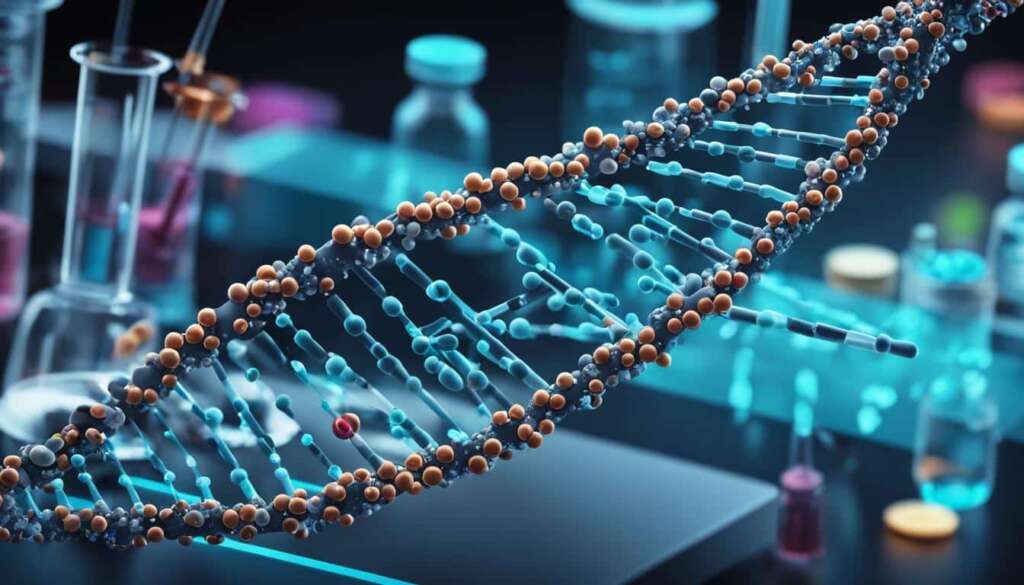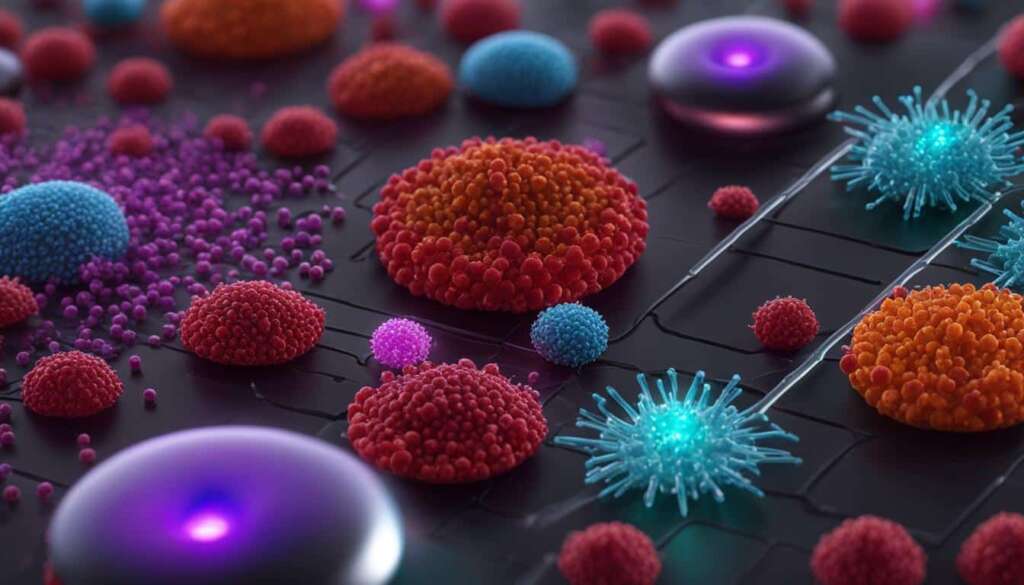Table of Contents
Nanotechnology in medicine is an emerging field that encompasses the application of nanotechnology to revolutionise healthcare. With the potential to improve treatment efficacy, drug delivery systems, and diagnostic techniques, nanomedicine is paving the way for innovative and personalised healthcare solutions. This article will explore the current state of nanomedicine, its applications in various medical fields, and the barriers it faces. By harnessing the power of nanotechnology, we can expect to see significant advancements in the way we prevent, diagnose, and treat diseases.
Key Takeaways:
- Nanotechnology in medicine has the potential to revolutionise healthcare
- Nanoparticles offer advantages such as improved drug delivery and enhanced diagnostics
- Nanomedicine is already being used in drug delivery, diagnostics, and regenerative medicine
- Emerging trends in nanomedicine include personalised medicine and controlled drug release
- Ethical considerations and collaborations are essential for responsible development of nanomedicine
What is Nanotechnology?
Nanotechnology is the science and manipulation of materials at the nanoscale, typically between 1 to 100 nanometers in diameter. At this scale, materials exhibit unique physical and chemical properties that can be harnessed for medical applications. Nanoparticles, with their small size and large surface area, offer advantages such as improved solubility, increased bioavailability, and enhanced drug delivery.
The nanoscale refers to the size range in which nanotechnology operates and encompasses the study and control of materials at the atomic and molecular level. It involves manipulating the properties of materials to create new structures and functionalities that can be used in various fields, including medicine. The small size of nanoparticles allows them to interact with cells and tissues in ways that larger particles cannot, making them suitable for targeted therapies, imaging, and diagnostics.
One of the key physical characteristics of nanoscale materials is their large surface area relative to their volume. Due to their small size, nanoparticles possess an increased surface area per unit mass compared to bulk materials. This unique feature makes them efficient in interactions with biological systems, facilitating drug delivery, tissue engineering, and other biomedical applications.
“Nanotechnology is poised to revolutionize medicine by offering innovative solutions for personalized treatments and diagnostics. The ability to manipulate materials at the nanoscale opens up new possibilities for addressing medical challenges and improving patient outcomes.”
In addition to size and surface area, the shape of nanoparticles also plays a crucial role in their functionality. Different shapes, such as spheres, rods, or tubes, exhibit distinct properties that can be tailored for specific applications. For example, rod-shaped nanoparticles may have increased cellular uptake, while spherical nanoparticles may have enhanced stability or optical properties.
Nanoparticles can be designed to carry therapeutic agents, such as drugs or RNA molecules, to targeted sites in the body. By functionalizing their surface with specific ligands or antibodies, nanoparticles can actively bind to diseased cells or tissues, allowing for precise drug delivery and reducing the potential for off-target effects. Furthermore, nanoscale materials can be engineered to respond to external stimuli, such as light or magnetic fields, enabling controlled drug release.
Advantages of Nanoparticles in Medicine:
- Improved solubility: Nanoparticles can enhance the solubility of poorly soluble drugs, improving their bioavailability and therapeutic efficacy.
- Increased drug delivery: The small size and unique surface properties of nanoparticles facilitate targeted drug delivery to specific cells or tissues, minimizing side effects and maximizing therapeutic outcomes.
- Enhanced imaging and diagnostics: Nanoparticles can be utilized as contrast agents for medical imaging techniques, providing detailed insights into cellular structures and disease progression.
- Versatility: The size and shape of nanoparticles can be tailored to specific applications, making them versatile tools in medicine, ranging from drug delivery systems to tissue engineering constructs.
By harnessing the potential of nanotechnology, scientists and researchers are unlocking new possibilities for medical advancements. The unique physical characteristics, size, shape, and surface area of nanoparticles provide a solid foundation for developing innovative solutions in the field of nanomedicine.
Current Applications of Nanomedicine
Nanomedicine is revolutionizing various medical fields and showing immense potential in healthcare advancements. The application of nanotechnology in drug delivery, diagnostics, regenerative medicine, and implants is driving transformative changes in medical treatments.
Nanotechnology in Drug Delivery
In the field of drug delivery, nanoparticles are proving to be game-changers. These microscopic particles can enhance the efficacy of medications by specifically targeting and delivering drugs to diseased cells or tissues. By directly targeting the affected areas, nanomedicine reduces drug doses, minimizes side effects, and improves treatment outcomes.
Nanotechnology in Diagnostics
The use of nanotechnology in diagnostics has revolutionized disease detection. Nanoparticles are employed to develop highly sensitive nanodiagnostic platforms that enable early and accurate identification of diseases. This technology plays a crucial role in identifying and monitoring biomarkers, facilitating timely interventions and personalized treatment plans.
Nanotechnology in Regenerative Medicine
Nanomaterials are being explored for their immense potential in regenerative medicine. These materials can be used to develop personalized implants that facilitate tissue regeneration and repair damaged organs or tissues. With nanotechnology, regenerative medicine offers hope for individuals suffering from conditions that were previously untreatable.
Nanotechnology in Implants
Nanomedicine is transforming the field of implants by introducing advanced materials with enhanced biocompatibility and functionality. Nanomaterials can be designed to mimic natural tissues, allowing for seamless integration with the human body. Additionally, nanotechnology enables the development of implants with controlled release capabilities, improving patient outcomes and reducing the need for invasive procedures.

In summary, the current applications of nanomedicine in drug delivery, diagnostics, regenerative medicine, and implants showcase the immense potential of nanotechnology in transforming medical treatments. By leveraging the unique properties of nanoparticles and nanomaterials, nanomedicine offers improved efficacy, precision, and personalized healthcare solutions.
Emerging Trends in Nanomedicine
One of the emerging trends in nanomedicine is personalized medicine, where treatments are tailored to individual patients based on their genetic makeup and other factors. By leveraging nanotechnology, healthcare providers can develop customized treatment plans that take into account a patient’s unique characteristics and needs.
Nanotechnology also enables controlled drug release, which is crucial in optimizing therapeutic outcomes. Through the use of nanoscale drug delivery systems, medications can be released in a controlled manner, targeting specific sites in the body and ensuring optimal efficacy while minimizing side effects.
Theragnostics represents the fusion of diagnosis and therapy, allowing for both to occur simultaneously. This innovative approach involves monitoring the biological response to treatment in real-time, enabling healthcare providers to adjust therapies as needed and ensuring more accurate and effective treatment outcomes.
These emerging trends in nanomedicine have the potential to significantly improve patient outcomes and transform healthcare. By harnessing the power of nanotechnology, personalized medicine, controlled drug release, and theragnostics can revolutionize the way we diagnose and treat diseases, leading to more effective and tailored healthcare interventions.
Barriers Faced by Nanomedicine
While nanomedicine holds great promise, there are several barriers that need to be addressed. These challenges encompass regulation, manufacturing procedures, quality control, and funding.
Regulation and standardization of manufacturing procedures and quality control are critical for ensuring the safety and efficacy of nanomedicine. With the rapid development and innovative nature of nanotechnology, it is crucial to establish comprehensive guidelines and regulations to govern its implementation in healthcare. By doing so, we can maintain ethical standards and protect patient well-being.
Furthermore, investment in infrastructure and collaboration with the private sector are essential for the development and commercialization of nanomedicine. By fostering partnerships between academic institutions, industry leaders, and healthcare providers, we can leverage collective expertise and resources to overcome barriers and facilitate the integration of nanomedicine into clinical practice.
However, one of the significant challenges faced by nanomedicine is funding. Adequate financial resources are required to support research endeavors, validate findings, and translate discoveries into real-world applications. The availability of funding plays a crucial role in driving innovation and ensuring the continuity of groundbreaking research in the field.
By addressing these barriers, we can unlock the full potential of nanomedicine and pave the way for transformative advancements in healthcare. Regulation, manufacturing procedures, quality control, and funding are key areas that require strategic attention and collaborative efforts to ensure the responsible and successful integration of nanomedicine into clinical practice.
Key Points:
- Regulation and standardization of manufacturing procedures and quality control are crucial for the safe and effective implementation of nanomedicine.
- Investment in infrastructure and collaboration with the private sector are essential for the development and commercialization of nanomedicine.
- Funding is needed to support research and overcome barriers within the field of nanomedicine.
Future Directions and Innovations in Nanomedicine
The future of nanomedicine holds great promise, with ongoing research and development in various areas. Scientists and researchers are exploring groundbreaking technologies and innovations that have the potential to revolutionize healthcare. These future directions in nanomedicine include the development of nanobots, the integration of artificial intelligence, and the utilization of gene editing techniques.
Nanobots: Revolutionizing Targeted Drug Delivery and Diagnostics
Nanobots, also known as nanorobots, are tiny robots designed to navigate the human body at a molecular level. These miniature devices have the potential to revolutionize targeted drug delivery and diagnostics. By precisely delivering medications to specific locations in the body, nanobots can enhance the effectiveness of treatments while minimizing side effects. Moreover, nanobots can be programmed to detect and diagnose diseases at their earliest stages, allowing for timely intervention and improved patient outcomes.
Artificial Intelligence: Advancing Personalized Treatments and Predictive Models
Artificial intelligence (AI) is becoming increasingly integrated into the field of nanomedicine. AI algorithms can analyze large amounts of biological data, such as genetic information and patient records, to assist in the development of personalized treatments. By leveraging AI, healthcare providers can identify patterns, predict disease progression, and determine the most effective interventions for individual patients. This integration of AI in nanomedicine has the potential to revolutionize healthcare by enabling precision medicine on a vast scale.
Gene Editing Techniques: Unlocking New Possibilities for Treating Genetic Disorders
The combination of gene editing techniques, such as CRISPR-Cas9, with nanotechnology opens up new possibilities for treating genetic disorders. Nanoparticles can be used as carriers to deliver gene-editing tools to specific cells or tissues, allowing for precise genetic modifications. Gene editing, coupled with nanomedicine, offers the potential to correct mutations and restore normal gene function, providing hope for individuals with genetic diseases.
In conclusion, the future of nanomedicine is filled with exciting innovations and advancements. Nanobots, artificial intelligence, and gene editing techniques offer new avenues for targeted drug delivery, personalized treatments, and precise genetic modifications. These future directions in nanomedicine have the potential to transform healthcare, revolutionizing the way diseases are treated and managed. As researchers continue to push the boundaries of nanotechnology, we can look forward to a future with improved healthcare outcomes and enhanced quality of life.

Ethical Considerations in Nanomedicine
As nanomedicine continues to advance at a rapid pace, it brings with it a host of ethical implications that require careful consideration. These ethical considerations are vital for ensuring the responsible development and implementation of nanotechnology in healthcare.
One of the primary areas of concern is privacy. The collection and use of personal data in personalized treatments and diagnostics raise significant privacy concerns. It is crucial to establish robust protocols and safeguards to protect patient information and ensure that their privacy is maintained throughout the process.
Safety is another critical aspect that needs to be thoroughly investigated. Nanomaterials may possess unique characteristics and potential risks that require comprehensive evaluation. Rigorous safety assessments must be conducted to minimize potential harm to patients and healthcare providers. Safety guidelines and protocols should be established and strictly adhered to, prioritizing patient well-being at all times.
Equity and accessibility also need to be addressed in the context of nanomedicine. It is essential to ensure that healthcare advancements in nanomedicine are accessible to all individuals, regardless of their socioeconomic background. Equity in access to nanomedicine treatments is crucial for fostering a fair and just healthcare system.
To navigate these ethical considerations effectively, the development of ethical frameworks and guidelines is imperative. These frameworks should be rooted in solidarity, respect, and fairness, guiding the responsible use of nanomedicine. They should be developed collaboratively, involving experts from various fields and stakeholders, to ensure inclusivity and balanced decision-making.
“Ethical considerations are vital for ensuring the responsible development and implementation of nanotechnology in healthcare.”
Overall, as nanomedicine transforms healthcare, addressing the ethical implications becomes paramount. By prioritizing privacy, safety, equity, and the development of comprehensive ethical frameworks, we can navigate the challenges associated with nanomedicine and ensure that its potential benefits are realized while upholding the highest ethical standards.
Nanomedicine and Global Health
Nanomedicine has the potential to address some of the greatest global health challenges, particularly in resource-limited settings where infectious diseases pose a significant threat. By leveraging the power of nanotechnology, innovative solutions can be developed to improve healthcare outcomes and reduce health disparities worldwide.
Nanotechnology-based diagnostics play a crucial role in combating infectious diseases. These advanced diagnostic tools can rapidly and accurately detect diseases, enabling timely interventions and effective management. By providing accurate and efficient disease detection, nanomedicine can help healthcare professionals in making informed decisions and implementing appropriate treatment strategies.
In resource-limited settings, access to healthcare resources is often limited, making it difficult to provide adequate treatment. However, nanomedicine offers opportunities for targeted drug delivery, which can overcome the challenges of resource scarcity. Nanoparticles can be engineered to deliver drugs directly to diseased cells or tissues, enhancing treatment efficacy while minimizing side effects. This targeted drug delivery approach not only conserves valuable resources but also improves patient outcomes.
The integration of nanotechnology in global health efforts has the potential to reduce health disparities by providing more accessible and effective healthcare solutions. By leveraging nanomedicine, healthcare professionals can overcome the barriers posed by limited resources and deliver high-quality care to individuals in even the most remote and underprivileged areas.
With ongoing advancements in nanotechnology, the potential for addressing global health challenges continues to grow. Nanomedicine holds promise in developing novel treatments, diagnostics, and preventive strategies for infectious diseases. By fostering interdisciplinary collaborations and investing in research, governments, healthcare organizations, and the global community can collectively harness the power of nanomedicine to transform healthcare and improve the well-being of populations worldwide.
Collaborations and Partnerships in Nanomedicine
The field of nanomedicine requires strong collaborations and partnerships between academia, industry, and healthcare providers. Interdisciplinary collaborations, combining expertise in various scientific fields, can drive innovations and accelerate the translation of nanomedicine technologies into clinical practice. By pooling together knowledge and resources, academia, industry, and healthcare providers can work together to address the challenges in nanomedicine, from regulation to commercialization.
“Collaboration is key in the field of nanomedicine. By bringing together researchers, scientists, and professionals from academia, industry, and healthcare, we can unleash the full potential of nanotechnology in medicine.”
Academic research institutions play a crucial role in advancing nanomedicine through cutting-edge research and development. Their expertise helps in uncovering new ways to apply nanotechnology in healthcare. Industry partners, on the other hand, contribute their resources and expertise in manufacturing, scale-up, and commercialization of nanomedicine products. By bridging the gap between academia and industry, collaboration can ensure the successful translation of nanomedicine from the lab to real-world applications.
Healthcare providers, including hospitals and clinics, are vital partners in the implementation of nanomedicine technologies. Their firsthand experience with patient care and treatment allows for the validation and optimization of nanomedicine approaches. Collaborating with healthcare providers also facilitates the integration of nanomedicine into existing healthcare systems, ensuring that innovative nanotechnologies reach those who need them most.
Benefits of Collaborations and Partnerships:
- Enhanced knowledge sharing and expertise exchange
- Accelerated translation of nanomedicine technologies from lab to clinical practice
- Access to resources, funding, and infrastructure
- Validation and optimization of nanomedicine approaches through real-world implementation
- Increased scalability and commercialization potential
By fostering collaborations and partnerships, the potential of nanomedicine can be fully realized. Interdisciplinary efforts hold the key to unlocking the transformative power of nanotechnology in healthcare, leading to innovative solutions and improved patient outcomes.

Conclusion
Nanomedicine has the potential to revolutionize healthcare, offering personalized treatments, targeted drug delivery, and improved diagnostics. As we delve deeper into the possibilities of nanotechnology in medicine, we realize the immense potential it holds in addressing global health challenges and improving patient outcomes. The healthcare revolution brought about by nanomedicine is a significant advancement in medical science.
However, the realization of nanomedicine’s full potential requires overcoming ethical considerations, regulatory hurdles, and funding challenges. It is essential to establish ethical frameworks and guidelines to ensure responsible development and implementation of nanomedicine. Regulatory bodies need to address standardization and quality control issues to ensure the safe and effective use of nanomaterials in medical applications. Adequate funding and collaboration between academia, industry, and healthcare providers are crucial for research, development, and the commercialization of nanomedicine.
By fostering interdisciplinary collaborations and addressing these challenges, we can unlock the full potential of nanomedicine and shape the future of healthcare. Personalized treatments, targeted drug delivery systems, and improved diagnostics are just the beginning. With continued advancements in nanomedicine, we can expect to see even more groundbreaking innovations that will transform the way we prevent, diagnose, and treat diseases. The healthcare landscape is on the verge of a paradigm shift, and nanomedicine is at the forefront of this healthcare revolution.
FAQ
What is nanotechnology?
Nanotechnology is the science and manipulation of materials at the nanoscale, typically between 1 to 100 nanometers in diameter. At this scale, materials exhibit unique physical and chemical properties that can be harnessed for medical applications.
What are the current applications of nanomedicine?
Nanomedicine is already being used in various medical fields. It is used in drug delivery to specifically target diseased cells or tissues, reducing drug doses and side effects. Nanoparticles are also used in diagnostics for early and accurate disease detection. In regenerative medicine, nanomaterials are being explored for the development of personalized implants that can replace damaged tissue.
What are the emerging trends in nanomedicine?
Personalized medicine is an emerging trend where treatments are tailored to individual patients based on their genetic makeup. Nanotechnology enables controlled drug release, delivering therapeutic agents to specific sites over time. The fusion of diagnosis and therapy, known as theragnostics, allows for simultaneous diagnosis and treatment by monitoring the biological response to treatment.
What barriers does nanomedicine face?
Nanomedicine faces challenges such as regulation and standardization of manufacturing procedures and quality control. Investment in infrastructure and collaboration with the private sector are crucial for development and commercialization. Funding is also needed to support research and overcome barriers within the field.
What are the future directions and innovations in nanomedicine?
The future of nanomedicine includes the development of nanobots for targeted drug delivery and diagnostics. Artificial intelligence can assist in the analysis of biological data, enabling personalized treatments and predictive models. Gene editing techniques, combined with nanotechnology, may offer new possibilities for treating genetic disorders.
What ethical considerations are associated with nanomedicine?
Ethical considerations in nanomedicine include privacy concerns with the collection and use of personal data in personalized treatments and diagnostics. Safety issues must be carefully investigated to ensure the risks associated with nanomaterials are properly evaluated. Equity and access to nanomedicine treatments should also be considered to ensure healthcare advancements are accessible to all.
How can nanomedicine address global health challenges?
Nanotechnology-based diagnostics can provide rapid and accurate disease detection, allowing for timely interventions and effective management, particularly in the context of infectious diseases and resource-limited settings. Nanomedicine also offers opportunities for targeted drug delivery in regions with limited access to healthcare resources.
Why are collaborations and partnerships important in nanomedicine?
Collaborations and partnerships between academia, industry, and healthcare providers are important in nanomedicine. Interdisciplinary collaborations can drive innovations and accelerate the translation of nanomedicine technologies into clinical practice. Academic research institutions, industry partners, and healthcare providers can work together to address the challenges in nanomedicine, from regulation to commercialization.
What is the potential of nanomedicine in healthcare?
Nanomedicine has the potential to revolutionize healthcare by offering personalized treatments, targeted drug delivery, and improved diagnostics. By addressing ethical considerations, regulatory hurdles, and funding challenges, nanomedicine can fully realize its potential and shape the future of healthcare.













